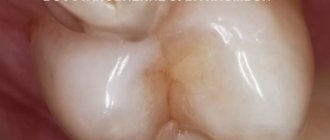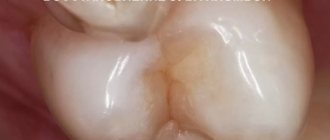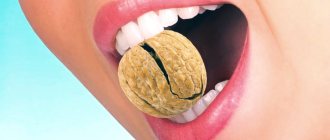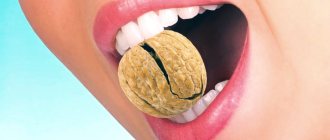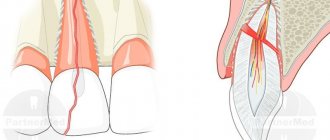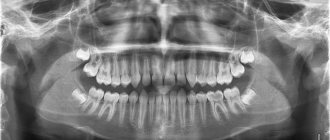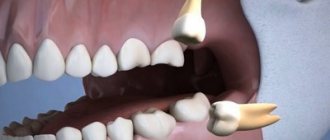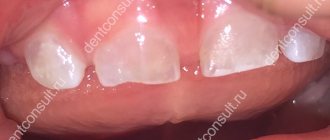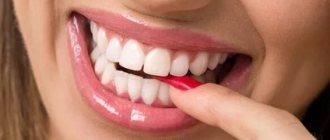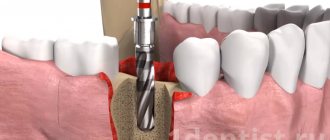Healthy teeth are firmly held in the gums by periodontium. Due to this feature, they can fluctuate freely in the gums, but such movements are not noticeable to humans. Even if you loosen the tooth with your finger, you won’t be able to feel that it is loose.
Thus, it turns out that a loose tooth is already obviously unhealthy. And it doesn’t matter at all whether a natural tooth is loose or a replacement implant of any format. From this material you will learn how dangerous it is to loosen an implant and what consequences can arise from this.
The ceramic lining on the crowns began to chip
The most likely cause is nocturnal bruxism. That is, in your sleep you clench your teeth and/or grind them uncontrollably. The reason for this is considered to be psychological stress.
Orthopedists often prescribe a night guard for these patients. Don't neglect her. It will cost money to have your teeth redone.
What to do? If you have these symptoms, your doctor will make a special night guard. It will need to be worn before bed to protect both the implants and teeth. At first it may cause slight discomfort.
Why might an implant become loose?
Looseness of the implant crowns can be caused by several reasons, and different parts of the prosthesis suffer. Sometimes it is the implant crown that begins to wobble relative to the abutment. In another case, the abutment is loose relative to the intraosseous part or the latter is loose relative to the jaw bone.
First of all, the solution to implant instability depends on the location of the problem. The reason may be incorrect fixation of the prosthesis initially during its immediate installation. If the doctor makes a mistake, the patient may suffer serious harm in the future.
Another common reason for the loosening of the prosthesis is ignoring the doctor’s recommendations for care and operating rules. Problems also often arise due to systemic problems with the patient’s health. The worse your health, the more serious problems will arise with your dentures.
Implant maintenance has become too expensive for me
Once every six months, it is recommended to have your teeth and implants professionally cleaned by a hygienist. The procedure is not very expensive (3000-6000 rubles), and in many clinics it is a mandatory item in the warranty program for implants. If you don’t take care of your implants at all (as well as healthy teeth), the risk of problems and complications increases. What to do? If you do not have the opportunity to visit a hygienist, focus on self-hygiene - this is not such a costly procedure. Check out our recommendations:
How to know if an implant has failed
| Click to sign up for a FREE consultation |
In most cases, loosening of the implant as a result of any violations of installation or operation continues with rejection of the prosthesis. It is easy to determine the rejection process by several signs that are difficult to miss. All these signs indicate that the implant has not taken root in the body:
- Swelling of the gums at the site of the implant does not go away for more than a week from the moment of installation. Swelling can also occur spontaneously after some time after installation.
- Sharp redness in the area where the implant is placed and around this part of the oral mucosa.
- An aggravated pain effect that manifests itself during chewing and spontaneously from the installation of the prosthesis.
- Discharge of blood and pus from the location of the artificial tooth.
- Strong bad breath caused by the discharge of pus.
- Looseness of the implant structure, felt when moving its fingers.
- The general state of health is deteriorating, local and general temperatures exceed the norm.
As soon as one or more of the above signs are detected, contact your doctor who will prescribe treatment. If you follow your doctor's instructions, you can avoid problems with the jaw bone tissue and its destruction. Please note that with a decrease in bone tissue at the site of implant installation and a local inflammatory process, the prosthesis is spontaneously removed from the gums. During this process, a sharp pain occurs that lasts quite a long time and without a doctor this disease cannot be cured.
Temporary crowns
The implantation process involves a fairly long (depending on the protocol) waiting period for the artificial root to take root. During this time, the patient is fitted with temporary prostheses.
Temporary crowns are made from inexpensive materials that do not have sufficient rigidity. If you don't take good care of them, infection can easily get to the tooth. Therefore, in most cases, the reason why a temporary crown on an implant becomes loose is non-compliance with the rules of care and excessive chewing load.
First actions
Immediately after the crown has fallen off, decisions must be thoughtful and balanced. The supporting part is very sensitive to external influences, light touches, and temperature changes. When a crown falls off, you need to make an appointment with a doctor as soon as possible, preferably on the same day. At this time, it is better not to eat to avoid microbes getting into the base of the stump. If this is not possible, you should try to put the prosthesis back for a while. Of course, if a crown falls off, it is forbidden to use ordinary office or household glue - special compounds sold in pharmacies should be used. It is very important to maintain sterile cleanliness when the crown comes off - at this time any touch can lead to infection. First aid involves sequentially performing the following actions.
- Buy special dental cement at the pharmacy. A pharmacist can advise you which one to choose.
- Wash the denture under warm water and soap, then dry thoroughly. Avoid applying pressure as this may cause deformation.
- Clean the inlay area with a soft brush and paste without abrasive ingredients. Rinse your mouth with water.
- Apply cement evenly to the inner surface of the denture. You can use a wooden stick or toothpick for this.
- Carefully place the denture on the tab, being careful not to get the composition on the gum. It is better to perform the procedure in front of a mirror.
- After making sure that the product is level, release your hand and clench your teeth. Stay in this position for 2-3 minutes: this is enough to fix it.
- If excess cement has formed around, it must be removed with dental floss. It must be applied carefully, without strong tension.
ATTENTION! You should not experiment by testing untested methods of traditional medicine. Doctors also do not recommend using herbal infusions for rinsing. Tea made from chamomile, St. John's wort, and yarrow certainly has antiseptic properties, but may contain small particles of the herb, which, if they get under the prosthesis, often cause inflammation.
Violation of the screw connection between the prosthesis and the implant
When a patient complains about the mobility of the prosthetic structure, the specialist first checks the stability of the supporting implant. If there are no problems with the root substitute and the bone tissue around it is quite dense, the problem may lie in the fixation screw. This is a fastening element that connects the prosthesis to the supporting part of the system. Often this is the reason why the crown on the implant has become loose. For example:
- The screw came loose. In this case, the dentist drills a hole in the crown to gain access to the retainer to re-tighten it.
- The screw broke. In such a situation, it has to be removed, then the structure must be secured with a new fixing element.
- Food debris got into the implant shaft. The screw is cleaned and replaced if there is no other damage.
Do you really have to put up with this?
Making dentures is quite a complex job, in some ways even comparable to art. Working in tandem, the orthopedic surgeon and the dental technician put a lot of effort into making an accurate and as comfortable prosthesis as possible. But in most cases, after putting it on and wearing it, it turns out that it needs some adjustment to the patient’s gums.
To regain lost comfort, you need to walk with the installed structure for 3–4 weeks. During this time, you can get used to the initially interfering prosthesis and get rid of the unpleasant sensations. If you simply remove it when discomfort appears, then you will have to describe all the inconveniences experienced in words, and the doctor will not be able to understand what exactly caused them. Do you want the correction to be effective? Be sure to come to your appointment wearing a prosthesis that causes discomfort.
Correction of dentures is carried out within 15–20 minutes. As a rule, it is possible to restore the patient’s comfort in one or two visits to the dental clinic.
In what cases can a fallen crown be put back?
Re-fixation of a permanent crown is possible if the following conditions are simultaneously present:
- if the supporting tooth is intact, has no chips or cracks,
- there is no need to treat/grind the tooth,
- if the prosthesis is not damaged or only slightly damaged: a small chip of ceramic on the metal “cap” can be restored.
It is also possible to reinstall a fallen temporary plastic or composite prosthesis. But all of the above conditions must also be met.
“A month and a half ago, I began to notice that the dental crown was moving out or seemed to be tilting. There was still no time to get to the doctor, and somehow I didn’t attach much importance. And while celebrating my sister’s birthday, I felt like I was chewing something wrong in my mouth. It turned out that the crown fell off while eating! I put it on a napkin and in my pocket. And the next day I went to the dentist. He examined everything, took an x-ray and said that we can glue it back and walk like this for a year or two.”
Alexander, review from the site irecommend.ru
Why do crowns break and fall out?
- Service life has expired. The service life of any crown is limited. Upon completion, the crown is changed.
- Oral hygiene was not maintained. Lack of proper care and poor hygiene are a common cause of premature loss or breakage of a prosthesis.
- Mechanical impact. The prosthesis breaks or falls out if the permissible load is exceeded. You cannot chew nuts with prosthetic teeth or use them for other purposes than as a “handy tool.”
- The base tooth has deteriorated. Continued destruction of a damaged tooth can lead to the crown falling out - it is not fixed in any way.
- Poor quality work of a dentist or orthopedic dentist. Even minimal deviations from manufacturing technology, inaccuracies in size or geometric configuration, improper preparation of prosthetics - all this can lead to premature failure of the crown.
Even a perfectly manufactured and installed crown can accidentally fall out or break. To minimize the risk of losing it after dentures, undergo regular medical examinations with a dentist.
When the old denture cannot be glued into place
In a situation where a crown has fallen off a tooth, in the vast majority of cases it is not possible to fix it back. This is mainly because it is quite difficult to remove hardened cement from the support or from the inside of the “cap” without damaging living tissue or the material of the prosthesis. The structure itself will eventually “sit” loosely on the support (since the stump has been ground again), or after 1-2 months the person will notice that the dental crown is falling off again. Also, the dentist may refuse to install the fallen prosthesis back if there are factors that will be discussed below.
Complex on 4 OSSTEM implants with delayed loading - from RUB 170,000.
Complex implantation Osstem (South Korea) with delayed loading after 4-6 months.
Guarantee for the doctor’s work - unlimited Call now or order a call
Opening hours: 24 hours a day - seven days a week
The prosthesis fell out along with the pin or stump insert
The pins and stump inlays are installed with the lower edge into the canals of the dental roots and secured with cement. And it is impossible to remove cement from narrow roots without dissecting part of your own tissues. Those. you will have to make a new inlay, because it must fit tightly to the walls of the canals (as well as a prosthesis, which inside repeats the shape of the top of the inlay). The pins have a standard shape, not a custom one, but they are very thin and often break off in the canal, i.e. With the prosthesis, only part of the pin falls out, while the other remains “walled up” in the canal. There is only one way out - to remove the entire tooth.
There is inflammation or cracks in the stump or root
A doctor can easily determine the presence of caries by darkened enamel, dentin, and a carious cavity on the stump. This requires drilling out all affected tissues, restoring the shape of the support and strengthening it (for example, with a filling or stump inlay). But it will not be possible to exactly repeat the original form.
Caries and cracks in the roots are detected using X-ray diagnostics or more accurate computed tomography. Depending on the situation, the dentist either goes through the canals, strengthens them with pins and fills them, or installs a core inlay, which will give strength to the restoration. Of course, it is impossible to reinstall the old structure in these situations.
Not only the prosthesis fell out, but the entire tooth along with the root
This happens in severe forms of periodontitis, periodontal disease, with massive cysts and granulomas at the roots. These formations appear against the background of the penetration of infection from the root canal into the periodontium - the ligamentous apparatus connecting the root to the bone socket. If a tooth falls out, you need to select a different type of prosthesis.
What causes the crown to become loose?
Part of the dental examination is taking an anamnesis, especially if the denture is several years old and you came to a different doctor with a problem than the one who installed it.
The fact is that there are objective reasons for the loosening of crowns.
Dental cement changes its structure over time, and its adhesive (adhesion-promoting) properties are lost. The crowns on the front teeth become loose especially often, because each bite leads to less grip.
Another objective reason is gum recession (loss). With age, the gums sag, covering the roots less and less. A gap forms between the restoration and the gum, where food debris gets in and colonies of bacteria begin to flourish. They destroy hard tissues, the stump becomes smaller, and the prosthesis cannot stay on it.
Therefore, dentists recommend replacing crowns regularly. Most often, a metal-ceramic crown wobbles, because the stump is heavily ground down for it, and the structure itself is massive, with thick walls. The service life of such crowns is the shortest: 5-7 years
. The stronger the material, the thinner the crown, the better the fit, and therefore the longer the service life. Therefore, ceramic restorations and products made from zirconium dioxide can be worn for decades.
But there are other reasons why the crown on a tooth becomes loose.
- Incorrect preparation
The stump for prosthetics must meet certain requirements: slightly taper towards the lower edge, be at least 3 mm in height (4 mm for molars).
If the doctor did excessive grinding, then the crown will slide off the tooth like a slide, even in the presence of cement. There should be a minimum gap between the tooth stump and the walls of the crown. The smaller the gap, the more reliable it is.
Perhaps the tooth was initially short and the doctor did nothing to grow it to the desired size. You can glue the crown, but it will still fall off. The higher the tooth, the better the crown is fixed on it.
The solution to the problem is to build up the stump with composite materials or inlays.
- Problems with cement
Dental materials are expensive and some clinics buy cheap materials from unknown manufacturers. Patients suffer from such savings.
Another case is when the cement is of high quality, but the technology for its preparation has been violated. The adhesive properties of such cement will not be good enough for the prosthesis to last for several years.
When re-prosthetics or re-installation, it is necessary to maintain proportions when mixing cement and use a quality product.
- Violation of manufacturing technology
The quality of the crown depends not only on the orthopedist, but also on the technician who makes it. A qualified technician follows all the requirements for the manufacturing process and always carries out sandblasting. It makes the inner surface rough, and this increases adhesion (adhesion).
Compliance with manufacturing requirements will improve the quality of the prosthesis and extend its service life.
- Loss of hard tissue
Before prosthetics, teeth are often depulped and the nerve (pulp) is removed. Therefore, during caries, the tooth under the crown does not hurt, but it can be destroyed. If caries destroys most of the hard tissues, the crown will begin to wobble, because the volume of the stump will decrease.
The patient himself can understand that the tooth under restoration is inflamed only by the smell from under the crown. In dentistry, for diagnosis, a targeted photograph is used, in which the lesion is visible. After treatment, the orthopedist will build up the stump or use microprostheses before installing the crown. If the tooth cannot be saved, it will be removed. The dentition can be restored with a bridge or implant. Implantation will avoid grinding down adjacent teeth and prevent bone loss. The bridge cannot stop atrophy.
